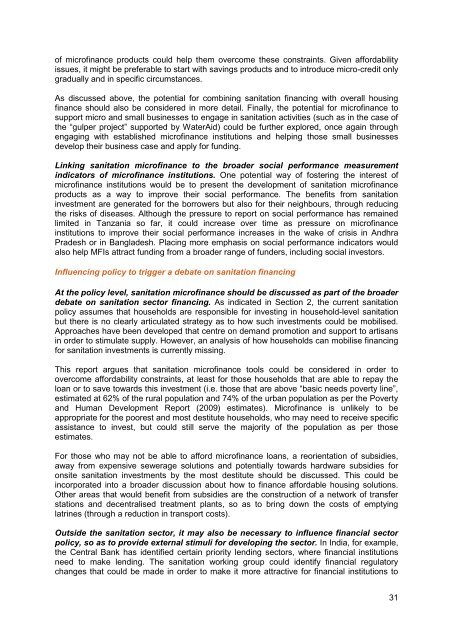REPORT__Evaluating_the_potential_of_microfinance_for_sanitation_in_Tanzania_May_2013
REPORT__Evaluating_the_potential_of_microfinance_for_sanitation_in_Tanzania_May_2013
REPORT__Evaluating_the_potential_of_microfinance_for_sanitation_in_Tanzania_May_2013
You also want an ePaper? Increase the reach of your titles
YUMPU automatically turns print PDFs into web optimized ePapers that Google loves.
<strong>of</strong> micr<strong>of</strong><strong>in</strong>ance products could help <strong>the</strong>m overcome <strong>the</strong>se constra<strong>in</strong>ts. Given af<strong>for</strong>dability<br />
issues, it might be preferable to start with sav<strong>in</strong>gs products and to <strong>in</strong>troduce micro-credit only<br />
gradually and <strong>in</strong> specific circumstances.<br />
As discussed above, <strong>the</strong> <strong>potential</strong> <strong>for</strong> comb<strong>in</strong><strong>in</strong>g <strong>sanitation</strong> f<strong>in</strong>anc<strong>in</strong>g with overall hous<strong>in</strong>g<br />
f<strong>in</strong>ance should also be considered <strong>in</strong> more detail. F<strong>in</strong>ally, <strong>the</strong> <strong>potential</strong> <strong>for</strong> micr<strong>of</strong><strong>in</strong>ance to<br />
support micro and small bus<strong>in</strong>esses to engage <strong>in</strong> <strong>sanitation</strong> activities (such as <strong>in</strong> <strong>the</strong> case <strong>of</strong><br />
<strong>the</strong> “gulper project” supported by WaterAid) could be fur<strong>the</strong>r explored, once aga<strong>in</strong> through<br />
engag<strong>in</strong>g with established micr<strong>of</strong><strong>in</strong>ance <strong>in</strong>stitutions and help<strong>in</strong>g those small bus<strong>in</strong>esses<br />
develop <strong>the</strong>ir bus<strong>in</strong>ess case and apply <strong>for</strong> fund<strong>in</strong>g.<br />
L<strong>in</strong>k<strong>in</strong>g <strong>sanitation</strong> micr<strong>of</strong><strong>in</strong>ance to <strong>the</strong> broader social per<strong>for</strong>mance measurement<br />
<strong>in</strong>dicators <strong>of</strong> micr<strong>of</strong><strong>in</strong>ance <strong>in</strong>stitutions. One <strong>potential</strong> way <strong>of</strong> foster<strong>in</strong>g <strong>the</strong> <strong>in</strong>terest <strong>of</strong><br />
micr<strong>of</strong><strong>in</strong>ance <strong>in</strong>stitutions would be to present <strong>the</strong> development <strong>of</strong> <strong>sanitation</strong> micr<strong>of</strong><strong>in</strong>ance<br />
products as a way to improve <strong>the</strong>ir social per<strong>for</strong>mance. The benefits from <strong>sanitation</strong><br />
<strong>in</strong>vestment are generated <strong>for</strong> <strong>the</strong> borrowers but also <strong>for</strong> <strong>the</strong>ir neighbours, through reduc<strong>in</strong>g<br />
<strong>the</strong> risks <strong>of</strong> diseases. Although <strong>the</strong> pressure to report on social per<strong>for</strong>mance has rema<strong>in</strong>ed<br />
limited <strong>in</strong> <strong>Tanzania</strong> so far, it could <strong>in</strong>crease over time as pressure on micr<strong>of</strong><strong>in</strong>ance<br />
<strong>in</strong>stitutions to improve <strong>the</strong>ir social per<strong>for</strong>mance <strong>in</strong>creases <strong>in</strong> <strong>the</strong> wake <strong>of</strong> crisis <strong>in</strong> Andhra<br />
Pradesh or <strong>in</strong> Bangladesh. Plac<strong>in</strong>g more emphasis on social per<strong>for</strong>mance <strong>in</strong>dicators would<br />
also help MFIs attract fund<strong>in</strong>g from a broader range <strong>of</strong> funders, <strong>in</strong>clud<strong>in</strong>g social <strong>in</strong>vestors.<br />
Influenc<strong>in</strong>g policy to trigger a debate on <strong>sanitation</strong> f<strong>in</strong>anc<strong>in</strong>g<br />
At <strong>the</strong> policy level, <strong>sanitation</strong> micr<strong>of</strong><strong>in</strong>ance should be discussed as part <strong>of</strong> <strong>the</strong> broader<br />
debate on <strong>sanitation</strong> sector f<strong>in</strong>anc<strong>in</strong>g. As <strong>in</strong>dicated <strong>in</strong> Section 2, <strong>the</strong> current <strong>sanitation</strong><br />
policy assumes that households are responsible <strong>for</strong> <strong>in</strong>vest<strong>in</strong>g <strong>in</strong> household-level <strong>sanitation</strong><br />
but <strong>the</strong>re is no clearly articulated strategy as to how such <strong>in</strong>vestments could be mobilised.<br />
Approaches have been developed that centre on demand promotion and support to artisans<br />
<strong>in</strong> order to stimulate supply. However, an analysis <strong>of</strong> how households can mobilise f<strong>in</strong>anc<strong>in</strong>g<br />
<strong>for</strong> <strong>sanitation</strong> <strong>in</strong>vestments is currently miss<strong>in</strong>g.<br />
This report argues that <strong>sanitation</strong> micr<strong>of</strong><strong>in</strong>ance tools could be considered <strong>in</strong> order to<br />
overcome af<strong>for</strong>dability constra<strong>in</strong>ts, at least <strong>for</strong> those households that are able to repay <strong>the</strong><br />
loan or to save towards this <strong>in</strong>vestment (i.e. those that are above “basic needs poverty l<strong>in</strong>e”,<br />
estimated at 62% <strong>of</strong> <strong>the</strong> rural population and 74% <strong>of</strong> <strong>the</strong> urban population as per <strong>the</strong> Poverty<br />
and Human Development Report (2009) estimates). Micr<strong>of</strong><strong>in</strong>ance is unlikely to be<br />
appropriate <strong>for</strong> <strong>the</strong> poorest and most destitute households, who may need to receive specific<br />
assistance to <strong>in</strong>vest, but could still serve <strong>the</strong> majority <strong>of</strong> <strong>the</strong> population as per those<br />
estimates.<br />
For those who may not be able to af<strong>for</strong>d micr<strong>of</strong><strong>in</strong>ance loans, a reorientation <strong>of</strong> subsidies,<br />
away from expensive sewerage solutions and <strong>potential</strong>ly towards hardware subsidies <strong>for</strong><br />
onsite <strong>sanitation</strong> <strong>in</strong>vestments by <strong>the</strong> most destitute should be discussed. This could be<br />
<strong>in</strong>corporated <strong>in</strong>to a broader discussion about how to f<strong>in</strong>ance af<strong>for</strong>dable hous<strong>in</strong>g solutions.<br />
O<strong>the</strong>r areas that would benefit from subsidies are <strong>the</strong> construction <strong>of</strong> a network <strong>of</strong> transfer<br />
stations and decentralised treatment plants, so as to br<strong>in</strong>g down <strong>the</strong> costs <strong>of</strong> empty<strong>in</strong>g<br />
latr<strong>in</strong>es (through a reduction <strong>in</strong> transport costs).<br />
Outside <strong>the</strong> <strong>sanitation</strong> sector, it may also be necessary to <strong>in</strong>fluence f<strong>in</strong>ancial sector<br />
policy, so as to provide external stimuli <strong>for</strong> develop<strong>in</strong>g <strong>the</strong> sector. In India, <strong>for</strong> example,<br />
<strong>the</strong> Central Bank has identified certa<strong>in</strong> priority lend<strong>in</strong>g sectors, where f<strong>in</strong>ancial <strong>in</strong>stitutions<br />
need to make lend<strong>in</strong>g. The <strong>sanitation</strong> work<strong>in</strong>g group could identify f<strong>in</strong>ancial regulatory<br />
changes that could be made <strong>in</strong> order to make it more attractive <strong>for</strong> f<strong>in</strong>ancial <strong>in</strong>stitutions to<br />
31


